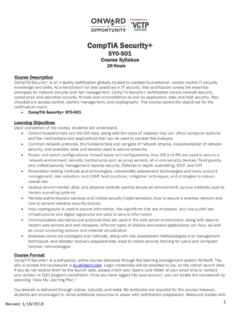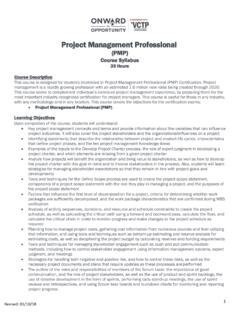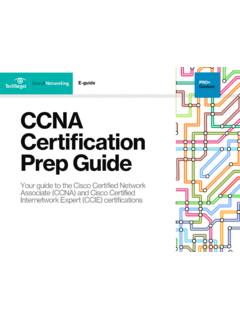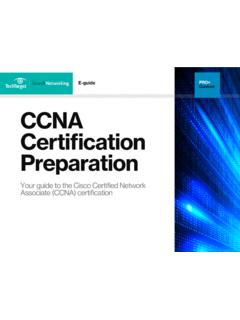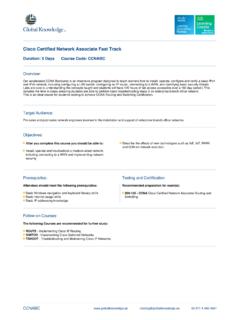Transcription of Cisco Certified Networking Associate - Syracuse University
1 1 Revised: 3/28/17 Cisco Certified Networking Associate 200-125 (ICND1 & ICND2) Course Syllabus 68 Hours Course Description The Cisco Certified Networking Associate (CCNA) certification provides students with the skills needed to install, configure, operate, and troubleshoot small to medium-size route and switched networks, including implementation and verification of connections to remote sites in a WAN. The exam tests a candidate's knowledge and skills related to LAN switching technologies, IPv4 and IPv6 routing technologies, WAN technologies, infrastructure services, and infrastructure maintenance.
2 This course covers the objectives for the certification exam: CCNA Exam 200-125 Learning Objectives Upon completion of the course, students will understand: Functions and management techniques of Cisco IOS, how routers and switches can be managed and maintained using IOS CLI; proper configuration a management IP address, a default gateway, and a hostname for a Catalyst IOS 2960 switch Identify Ethernet LAN media, describe functions of a switch, and troubleshoot communication issues with a structured plan; describe how switches handle different types of frames on an interface and how to troubleshoot connectivity issues with LAN Configuration of static routes, Host-to-Host packet delivery processes and how ARP contributes to this process on Ethernet links Creation and assignment of VLANs, implement Trunks, deploy Inter-VLAN routing and need for VLANs, Trunks, and Inter-VLAN Routing in modern day network deployments Concepts involved with network architecture including network devices, network services, network models, network cabling.
3 Network topologies and different WAN technologies available Need for FHRPs in redundant environments along with configuration and verification of HSRP Characteristics and behaviors of OSPFv2 and how it can be used to build large scale routing domains Foundational knowledge of Wans including how to research, deploy, manage, and maintain a WAN Configuring IOS routers and switches for RADIUS authentication services as well as definitions of simple network management protocols Foundations in network security, device monitoring, and need for Qos and various tools, features, and mechanisms that it offers Course Format CCNA is a self-paced, online course delivered through the learning management system Skillsoft.
4 The site to access the coursework is Login credentials will be provided to you on the cohort launch date. If you do not receive them by the launch date, please check your Spam/Junk folder of your email and/or contact your advisor or O2O program coordinator. Once you have logged into your account, you can locate the coursework by selecting View My Learning Plan. Coursework is delivered through videos, tutorials, and tests. No textbooks are required for the course; however, students are encouraged to utilize additional resources to assist with certification preparation.
5 Resource Guides with lists of supplemental study materials for each certification are available at 2 Revised: 3/28/17 Course Completion Requirements CCNA coursework is due within 90 days from the assignment date. The course hours listed at the top of the syllabus reflect the time it would take to click through the slides and do not account for taking notes or the end of module tests. You must complete all fourteen modules listed within Topic 1, and all ten modules listed in Topic 2. Successful completion of a module is marked after you review the lesson videos and score 80% or higher on the end of module tests.
6 At the beginning of a module, you will be asked to take a pre-test. Scoring 80% or higher on the pre-test signifies competence in the information that will be covered; you will therefore be waived from completing the module. A non-credit certificate of completion will be awarded for successful completion of the coursework. Industry Certification Requirements In order for the program to fund your CCNA certification exam you will need to meet the CCNA practice exam requirements. Your advisor or O2O program coordinator will provide you with access to the practice exam as well as completion instructions once you have finished the coursework.
7 Support For technical support, please contact Skillsoft Support at For course content support, please utilize Skillsoft s Ask My Mentor tool, located in the left-hand Menu within the module course player For program support or questions, please contact your advisor or O2O program coordinator Course Outline Topic 1: Server Technology Fundamentals (ICND1) Cisco ICND1 : An Introduction to Networking and Cisco IOS Cisco ICND1 : Managing Switches and Routers with Cisco IOS Cisco ICND1 : Discovering Ethernet and Troubleshooting Methodologies Cisco ICND1 : The Internet, Transport, and Application Layers Cisco ICND1 : Mastering IPv4 Addressing and Subnetting Cisco ICND1 : Discovering Cisco IOS Routers Cisco ICND1 : Understanding Host-to-Host Communication and Implementing Static Routing Cisco ICND1 : IPv4 Access Control Lists Cisco ICND1 : IPv4 Private to Public Network Address Translation Cisco ICND1 : VLANs, Trunking, and Inter-VLAN Routing Cisco ICND1 : Implementing DHCP and RIPv2 Cisco ICND1.
8 Securing Management Access on an IOS Device Cisco ICND1 : Implementing Port Security and Managing the Cisco IOS Cisco ICND1 : Introducing IPv6 Topic 2: Interconnecting Cisco Network Devices Part 2 (ICND2) Cisco ICND2 : Implementing and Troubleshooting VLANs, Trunks, and Etherchannel 3 Revised: 3/28/17 Cisco ICND2 : Working with Spanning-Tree and First Hop Redundancy Protocols Cisco ICND2 : Troubleshooting IPv4 Networks Cisco ICND2 : Troubleshooting IPv6 Networks Cisco ICND2 : Introducing Dynamic Routing Protocols and EIGRP for IPv4 Cisco ICND2 : Configuring and Verifying OSPFv2 Cisco ICND2 : Configuring and Verifying EIGRP for IPv6 and OSPFv3 Cisco ICND2 : Troubleshooting EIGRP for IPv4/IPv6 and Troubleshooting OSPFv2/OSPFv3 Cisco ICND2 : Wide Area Networks using PPP, GRE, and eBGP Cisco ICND2 : Mitigating Threats, Introducing SDN, and Examining QoS
